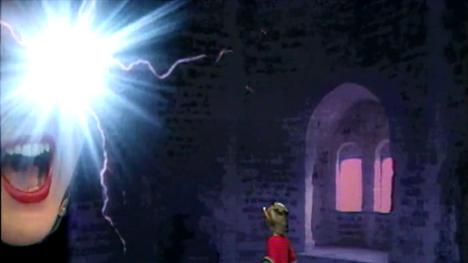What's new for Series 4 of Knightmare? A summary of the main differences.
Start of Series
Treguard has a new assistant in the antechamber.
- Treguard: "Welcome, watchers! Doesn't it seem an age since the last time? Not for me, perhaps, but you all look distinctly older."
An elf, Pickle, is sat by the fireplace. Treguard asks him to attend to the magic mirror.
- Pickle: "Mirror, mirror, on the wall, show the first brave stupid fool."
We see a preview of the dungeoneers before they are transported into the antechamber. They receive the usual quest items and guidance before they depart.
- Treguard: "From this moment on, your friends must be your eyes. You may only see where your feet have taken you, and no longer where the pathway leads."

Similarities and Differences
The dungeon has a very different look and feel to the previous years. Series 4 saw the introduction of outdoor locations and pre-shot video transitions between areas.
Knightmare was moving away from a randomised sequence of rooms and puzzles and closer towards fixed locations. This meant more obvious repetition, especially in the dialogue.
Rationale, from Tim Child
"The Knightmare adventures demanded movement, danger, atmosphere and a complex variety of scenes in which to stage the game.
"The Greater Game was becoming ever more hungry - ever more demanding of scenic complexity - and [Robert] Harris and [David] Rowe were at the limit of what could be achieved either with computer or paintbrush...

"So, if Virtual Reality wouldn't do the trick, how about plain reality? Britain was rich in real castles with real crumbling dungeons.
"Harris's relighting techniques could be used with any images, real or painted, so why not acquire a huge dungeon database by looting history?"
(A History of Knightmare: How Knightmare evolved)

Dungeon
A new opening 'Place of Choice' gave teams the choice between two of the four classic quest objects.
Like the previous series, each team faced a sort of 'sub-quest'. Early in Level 1, they were invited to assist a character by retrieving or delivering an object. They were rewarded for this in Level 3.
This 'sub-quest' enabled the introduction of another quest item - the Eye Shield. When a dungeoneer held up the Eye Shield, video footage showed the transition between locations.
Characters
Team knowledge was tested differently in Series 4. Weeping Doors asked true/false questions to guarantee at least some testing on each level, but the difficulty level was lower than earlier years.

New characters included a sorceress called Malice, who replaced Morghanna as a second opponent. Though not a separate friend/foe personality in the same way as Merlin and Mogdred, she too could be a help or a hindrance.
Gundrada, the outspoken 'Sword Mistress', was a near permanent fixture in Level 2, while the roaming Brother Mace proved a source of educated wit.
Start of Episode

There was no longer a recap of the previous episode. Instead, Pickle reviews a Book of Quests, which focuses solely on the current team in progress.
- Treguard: "Pickle, the Book of Quests, and the story so far..."
A new status bar to show progress was generated using the Commodore Amiga 2000. This appeared in-quest when a team picked up clue objects or received magic.
End of Episode
The bell still tolls to signal 'time out' or 'temporal disruption'. It often sent Pickle into disarray. Pickle would then ask about the watchers.
They'll just wander off and get up to all kinds of mischief. But they'll be back, and do you know why? Because like all young humans, they're incurably curious.
The closing titles for Series 4 included a montage of dungeoneer footage, unused rooms, and Gundrada fumbling her sword.

The titles for Episode 1 show an axe swinging in a circular motion across a narrow pathway. This room did not feature in Series 4, but it was used in the French adaptation, Le Chevalier du Labyrinthe.
During this series, Hordriss and Gundrada both made appearances on Children's ITV with presenters Jeanne Downs and Scally the Dog.



